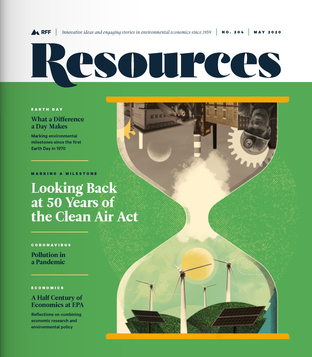
May 2020 / Magazine Issues
Issue 204: Looking Back at 50 Years of the Clean Air Act of 1970
A Note from RFF’s President about Resources issue 204:
This year marks 50 years of celebrating Earth Day; the existence of the US Environmental Protection Agency; and amendments to the Clean Air Act in 1970, which expanded the law’s federal mandate and enforcement.
In the year 2020—and recognizing that hindsight is 20/20—we’re looking back at our legislative and regulatory history and the important environmental accomplishments they have enabled. Retrospective analyses can give us the empirical data we need to make sound decisions moving forward—about how to modify current regulations so they work effectively and efficiently, prune policy elements that don’t justify their costs, and employ groundbreaking incentive mechanisms to maintain a thriving economy and a healthy environment at the same time.
This anniversary of the Clean Air Act is an excellent opportunity to showcase the value of empirical data in informing future policies and decisions. Two articles in this issue consider how the Clean Air Act has fared in practice:
- “Looking Back at 50 Years of the Clean Air Act of 1970,” by Joseph E. Aldy, Maximilian Auffhammer, Maureen L. Cropper, Arthur G. Fraas , and Richard D. Morgenstern
- “Lessons from the Clean Air Act,” which highlights a book by the same title published last year by Dallas Burtraw and UCLA Law Professor Ann Carlson
The rest of this issue explores other topics related to air quality:
- Alan Krupnick’s article explains how satellite data can supplement land-based monitoring to help states achieve compliance with National Ambient Air Quality Standards.
- Karen Palmer discusses recent proposed changes to the US Mercury and Air Toxics Standards.
- Nathan Richardson presents his view on whether the Clean Air Act can serve as a vehicle for broader environmental policy.
- Nicholas Z. Muller, a faculty member at Carnegie Mellon University, joins us on the Resources Radio podcast to discuss how to measure health damages from air pollution in various economic sectors in the United States, relative to the economic contributions of those sectors.
And some special additional highlights include the following:
- A timeline of more than 50 milestones to commemorate 50 years of concerted efforts toward sound environmental policy every Earth Day
- Observations from Richard D. Morgenstern about the growing role of economic analysis at the US Environmental Protection Agency, on its 50th birthday this year
- An article from the archives, written by Allen V. Kneese to reflect on the 30th anniversary of Earth Day in 1990, accompanied by a companion piece written by former RFF president Paul R. Portney
Richard G. Newell
President and CEO, Resources for the Future
Articles in this issue
Looking Back at 50 Years of the Clean Air Act of 1970

Team of Economists Calls Out Flawed Methods Applied to Justify MATS Rollbacks

Pollution and GDP

Lessons from the Clean Air Act

Satellites Can Supplement the Clean Air Act’s Land-Based Air Monitoring Network

Celebrating 50 Years of Earth Day

Confronting Future Environmental Challenges

Confronting a New Future of Environmental Challenges

Market-Based Approaches to Environmental Policy: A “Refresher” Course

The Rise and Fall of Clean Air Act Climate Policy

A Half Century of Economics at EPA

What’s at the Top of Your Stack?
